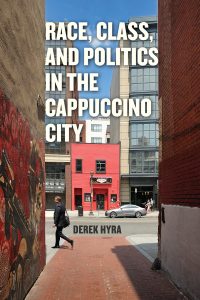Black branding in the Cappuccino City

Derek Hyra’s Race, Class, and Politics in the Cappuccino City, not only offers up an contemporary ethnography of gentrification—DC’s Shaw/U Street district—but also concretizes how we talk about urban displacement in neoliberal late capitalism, centered around the concepts of the “gilded ghetto,” “living the wire,” and the “cappuccino city.” A cappuccino is basically a cup of coffee with (steamed) milk, but costs nearly double or triple the price, depending on whether or not the espresso bean is artisanal, or if the foam is sculpted into a the shape of a leaf or a heart. In Hyra’s cappuccino city, our black inner-city neighborhoods, under pressure from the gig economy, gutted social programs, and real estate investors luring white millennials, undergo enormous transformations and become racially “lighter” and more expensive by the year.
You can listen to Hyra’s recent appearance on the Kojo Nnamdi Show here, or read an excerpt from a Washington Post profile after the jump.
***
“Black branding” describes how developers and other mostly white business interests actively promoted Shaw’s historic black identity as a marketing strategy to attract white renters and buyers. Their success helped tip the neighborhood’s demographics from 70 percent black in 1970 to 30 percent in 2010.
The Shaw/U Street area was an ideal candidate for such a sales job. U Street was known as the “Black Broadway” in the 1920s and 1930s, and the neighborhood nurtured cultural giants including musician Duke Ellington and poet Langston Hughes. Both are now memorialized in names of plush residential properties–”The Ellington” and “Langston Lofts.”
The advertising pitch represented a dramatic shift.
“Not long ago, an urban community’s association with blackness was mostly perceived as detrimental,” the book says. “But nowadays … neighborhood-based organizations, real estate developers, restaurant owners and urban planners commodify and appropriate aspects of blackness to promote tourism, homeownership, and community redevelopment.”
Hyra dubs a related trend as “living the wire” where whites in their 20s and 30s seek the titillation of living in a community with a hint of the urban grit of the Baltimore ghetto portrayed in the TV series “The Wire.”
He also faults the practice as a new form of urban slumming.
***
To read more about the book, click here.